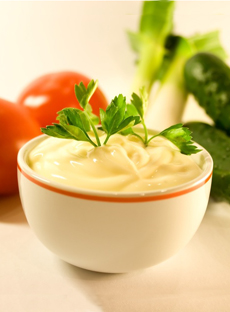Rickshaw or Ricksha
Rickshaw pulling is a popular and easy profession in Bangladesh. A rickshaw puller earns about US $2.00-3.00/day. He can either own a rickshaw or hire one from his master. A rickshaw must be registered at the local municipalitym and during the evening and night the rickshaw must equipped with a Hurricane-lamp at the back and a small headlight at the front. Rickshaws are comfortable and a cheap transport system, and definitely do not pollute the environment.
Should we feel proud about the rickshaw – as an inhuman vehicle? It shocks people in other countries when a plump of flesh (two-three women) boards a rickshaw with heaps of luggage and orders the aged rickshaw puller to run fast. But do we even offer a glass of cold water to the rickshaw puller who is far more thirsty than the passengers?
A little history about rickshaw
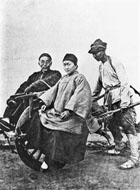
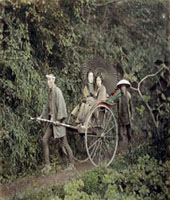
As a mode of transport rickshaw was first introduced in Japan in the early twentieth century. This mode of transport became particularly popular there due to the Second World War situation, which made petrol and motorised transport scarce and expensive. Japan, however, had soon replaced rickshaw, nintaku in Japanese, with motorised vehicles and by the 1950s the cycle rickshaw had disappeared from Japan. There were also rickshaws in china at that time.In the 1930 and early ’40s rickshaw became popular in Indonesia, Singapore and other Southeast Asian countries. Rickshaw is said to have reached Chittagong from Myanmar in 1919. Interestingly, rickshaw did not spread out to Dhaka and other cities of Bangladesh from Chittagong. Dhaka got rickshaw from Calcutta, where it was first introduced around 1930. European jute exporters living in Narayanganj and Netrokona (in Mymensingh) had first imported cycle rickshaw from Calcutta in 1938 for their personal use. The new vehicle roused great curiosity among the people of Dhaka, who were traditionally used to horse carriages, palanquins and city-canal boats.
Rickshaw painter

Rickshaw repairman

Jalal, 75, “For 40 years I worked in Dhaka as a rickshaw puller. But then as I got older I grew weaker and weaker and finally I couldn’t drive the rickshaw anymore. So about three years ago I stopped completely and started work repairing rickshaws instead.
“About nine months ago, I had a heart attack, and couldn’t work at all for 2 months. I have two grown-up daughters and during the time when I was sick they took over the repair business for me. I have trained them both in how to repair rickshaws, so that if I die before they get married they will be able to earn a living. The problem is they could never earn as much as me because people wouldn’t want to get their rickshaw repaired by a woman.”
Child labor Rickshaw pusher

Solaiman (10 years old), Rickshaw pusher, He pushes rickshaw to help rickshaw puller for crossing the Loher pull bridge, Dhaka, Bangladesh. I was very surprised, when I saw the boy pushes the rickshaw to help the rickshaw puller. Because any time any unexpected incident can be happen. So, morally I do not support that kind of work. Government should take initiative action to stop child labor in Bangladesh.
Rickshaw driver at night

It is a popular guess that the total number of rickshaws in the city is at least two and a half times that of the registered ones and accordingly, the city had at least 280,000 rickshaws in 2000. Estimates based on the figures that each rickshaw is operated by two pullers in morning and evening shifts and the average number of family members of a rickshaw puller is five, suggest that the rickshaws of Dhaka city alone is a source of income for nearly three million people.
Lease on the rickshaw

The rickshaw “wala”, or driver, is the lifeblood of Bangladeshi culture. Most walas act as indentured servants essentially, pedaling all morning just to pay their daily lease on the rickshaw – then pedal all afternoon for the family and often work long shifts into the evening. Their rickshaws are inefficient and difficult to pedal. They’re banned on many streets in Dhaka, the capital, as they create even more congestion in an already chaotic city – the most raw, intense city that I’ve seen.
Rickshaw Festival

Dhaka, known as the ‘rickshaw capital of the world’, saw its first ever Rickshaw Festival on Sat, Mar 28th, 2009. Approximately 400,000 cycle-powered rickshaws run in the capital each day. However, increasing traffic congestion and resulting collisions have led to their ban on many of Dhaka‘s major roads. Some fear a total ban in the city before long, putting an end to a century-old tradition.
“The festival is meant to promote this environment-friendly vehicle, and the rickshaw-pulling community, that caters to a vast majority of people in the country,” said Sara Siddiq, CEO of Bangladesh Change makers, the festival organizers. “It is also meant to raise the profile of Bangladeshi heritage and culture,” she told bdnews24.com.
Children and adults thronged the colorful day-long event at New Colony Field in Lalmatia.
Two public universities, including Dhaka University, and 15 private universities also assisted in hosting the programme, which included rickshaw pullers presenting traditional song and dance and showcased the rickshaw painters’ famously elaborate and colourful illustrations.
It also allowed festival goers to try their own hand at rickshaw art and take part in rickshaw races. Most of them said they would be extremely sad if their favourite vehicle were banned from the streets of Dhaka. “The rickshaw is the middle class’s favourite vehicle, and pollution-free,” said one rickshaw lover. Giving no names, one young couple declared there was nothing to compare to taking a romantic rickshaw ride with a loved one!
The real bases of exploitation

This argument is driven by the immediacy of the relationship between the puller and the pulled: no one advocates that the bus driver or aeroplane pilot is also been exploited. The overriding reason is the energy that the puller must exert to move the passengers’ weight. Yet this is not an unfair relationship perse. Campaigns that promote the idea of rickshaws as exploitative highlight only one aspect of the work, confusing the moral questions of labour type with the economic conditions of the labour process.
Morally, we should see no concern in the existence of rickshaw pulling as a profession. The moral issue surrounds the question as to why rickshaw pullers come to do this job, what structures and social relations are forcing people to take this work, and which members of society are pullers and which are pulled. This is where the exploitation of rickshaws emerges, in the conditions of their labour.
The way that users treat rickshaw pullers, the fares that can be charged, the housing that pullers have, the costs of rickshaw rents, their relationship with the police, the attitude of policy makers –- these, and not the act of pulling, are the conduits through which exploitation takes place. Combined, these have had the effect to prescribe rickshaw pulling as a low-status, ill-respected activity that must be replaced by other means, and one from which pullers seek to ‘escape’ as soon as possible.
Floating Rickshaw

This old man, Mr.Mohamad Saidullah, who is just a Rickshaw puller, helped several people in the flood hit Bihar with his wonderful invention (innovation) of floating Rickshaw. The best part is when all the cars and sophisticated vehicles were off the road and the authorities were struggling to help the stranded, this man helped ferry several people to safety.
Rickshaw puller’s house

A woman sits with her child on the threshold of her shack in a bamboo slum. Her home is built directly over a pool of chemical waste from a nearby tannery plant which processes animal hide to make leather. The only way she and her children can get out of their house is by wading through the toxic water.
Rickshaw puller fight with car driver

A cart driver, left and a rickshaw puller are seen engaged in a fight after the cart, partly seen left, and a rickshaw, background center, collided in Dhaka, Bangladesh, Saturday, Dec. 27, 2008. It is estimated that over a quarter million rickshaws ply in the Bangladeshi capital.
Use of Rickshaw During Natural Disaster

It was rainy season. A Bangladeshi rickshaw puller waits for a passenger on a rain stormed street. That day they did get many passengers. So, they did not earn more money. It is true scenario of Bangladesh Rickshaw puller’s that they are most helpless people among others.

A rickshaw puller rides in the rain in Allahabad, India, Tuesday, July 3, 2007.At least 14 people were crushed to death or drowned overnight when heavy rains lashed eastern and western parts of India, taking the country’s monsoon death toll to 121, police said Tuesday. (AP Photo / Rajesh Kumar Singh)
A typical rickshaw garage

The conditions of life for rickshaw pullers further demonstrated their helplessness and marginality. Those, that do no live in their own homes (and given that most are migratory to the cities from famine or flood affected areas, these are few) will live in garages. The garage is typically a raised shed, with rickshaws underneath and up to fifty men crowded together on the floor.
Residential background

Men from different areas of the country do not participate equally as rickshaw pullers in the Dhaka City. The three largest contributing districts are Mymensingh, Rangpur and Barisal, from which more than half (52%) of the sample rickshaw pullers had come. The next largest contributors are Bogra, Faridpur, Dhaka, Dinajpur and Comilla from which about one-third of the pullers have come. Thus, districts having extensive less than 1% of males aged above 20 years are widowed or divorced. Multiple asset and process indicators may be considered to ascertain whether a particular social category belongs to the most disadvantaged groups. Severe poverty, depressed areas, river erosion, chars lands, and/or underdeveloped areas with limited work opportunities dominate in the sample of rickshaw pullers. All most every persons of the rickshaw driver comes from lower class in Bangladesh society. The village of Bangladesh has no enough job opportunities. These why maximum village people come in Dhaka city for survive their life.
Peoples’ art
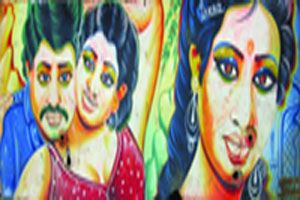
Simple but eye catching

Art moving by on wheels needs to be bold and eye-catching. Rickshaw artists aim to decorate the vehicles with as much drama and colour as possible, and paint images that are both simple and memorable.
Blaze of colours
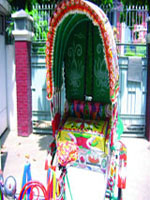
Rickshaw is not only moves with the passenger and other load, but it moves with a museum full of folk arts. Every inch of the Rickshaw is well decorated with paintings, tassels, tinsel and colourful plastic and hood works. Rickshaw hoods, foot holds, seats and in the back side, even in frame and in chassis there is a sign of art. A painted rectangular metal board at the backside, between the two wheels, leaves a trail of passion that the Rickshaw artist puts in his creations. In a word a Rickshaw of Bangladesh is a burn of colours.





